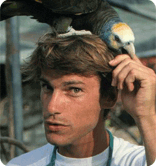Feral parrot flock in Miami

Miami Florida has a feral flock of over 20 Blue and gold Macaws that have been existing for over 30 years. Bill Pranty wrote an article published in the Florida Field Naturalist (Vol.38, No 2) published by the Florida Ornithological Society. I’m second author as I’ve collected data and been involved with the macaws for 15 years. I am asking for advise about building suitable artificial nest boxes. The wild flock’s main problem is finding dead palms as people in an upscale urban immediately cut dead palms down.
The Tropical Audubon Society is 100 % in favor and helped me put up a commercial box that failed because we probably used the wrong tree and bees inhabited it immediately. I have the financial means to put up these nesting boxes myself but want to do it properly this time. Correct design and correct location. By the way, the wild macaws are attracted to my backyard feeder because I live opposite a wildlife refuge, near Fairchild Tropical Gardens and I have 5 large macaws (hens) as pets that I let fly free ( supervised). Part of the flock come daily.
Daria Feinstein

Dear Daria, Interesting question indeed! While we don't advocate for the promotion of non-native species, especially non-threatened species well outside their historic range, we can provide a bit of background as most of this information is readily available on the web and in published papers and books.
Most macaw nest boxes are made either out of wood or PVC plastic, and there are benefits and drawbacks to both options. You can get lots of dimensions on the web, but in practice it seems the bigger the better for the internal dimensions. If the entrance is just big enough to allow the adults in (check with your captive birds), that should be fine. Often people staple wire mesh from the entrance to where the eggs and chicks sit so that the adults and later the chicks can easily climb up and down that surface. Or you can use roughened wood there if you prefer.
Some birds seem to prefer horizontal boxes rather than vertical ones, or a vertical entrance with a lower chamber which has a lot of floor space. Our field teams have reported that this species seems to nest almost exclusively in palms, so you may want to attach your boxes to palm trunks at least at first.
Bees are likely to be an issue for just about any box, and these non-natives are a serious pest of many cavity nesting birds, especially parrots. There are four options you might try, 1. hope for the best, 2. add another box for the bees with a small downward facing entrance and a pheromone lure (commercially available), 3. remove any hives that set up shop in your boxes, or 4. treat the boxes with an insecticide which is toxic to bees and not to parrots (Permethrin and Vapona have been used with success. The other thing that can help is to line the underside of the top of the box with plastic which the bees will have a hard time attaching their combs too and that seems to help. Obviously if you're using PVC for your lid, you're all set.
Given that you work with the Tropical Audubon Society, you should definitely address the fact that this species is not native to Florida, nor has there ever been a large macaw in North America as far as we know. Cuba isn't far off, and there was a Scarlet-like macaw there, so who knows, maybe some macaw bones will show up in the FL fossil record someday. In any case, at minimum, you should be clear from the start what your intention is with these birds. Is it a small and stable population there, is it a growing population, are you hoping these birds will represent an ecological replacement for a species which is now extinct? Feral parrots in FL are both common and controversial as I'm sure you're aware.
Good luck and please let us know how the birds are responding to your efforts,
Jamie

































